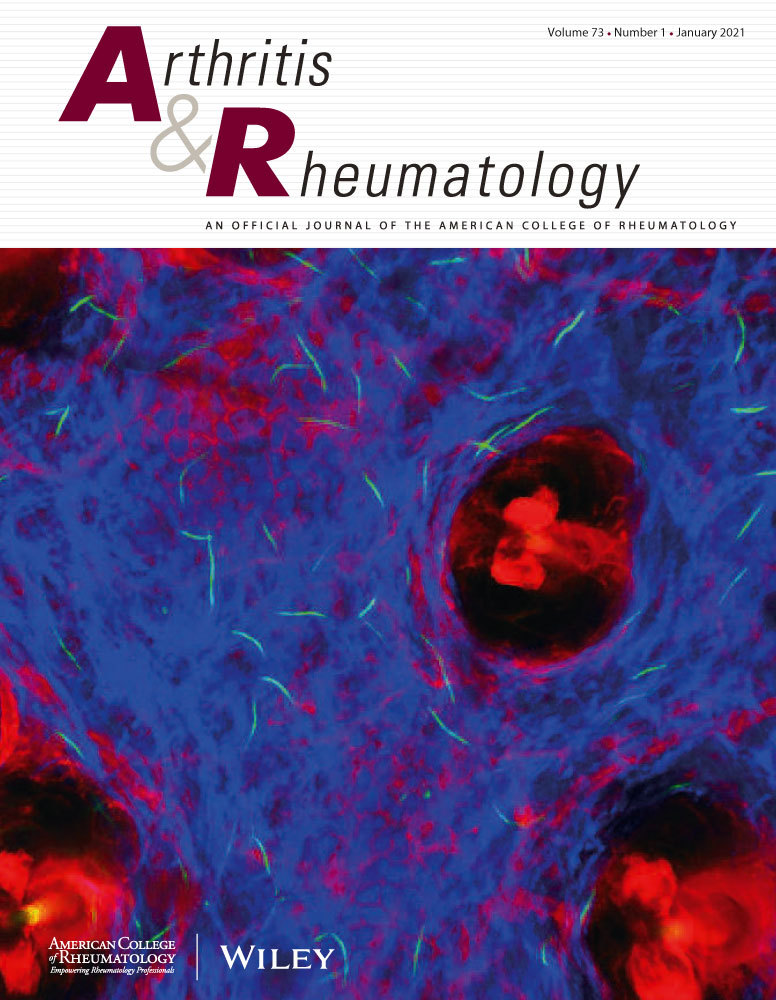Skin biopsies enhance prediction of clinical trajectory in diffuse cutaneous systemic sclerosis
IF 10.9
1区 医学
Q1 RHEUMATOLOGY
引用次数: 0
Abstract
ObjectivesTo evaluate the relationship of skin fibroblast CD34 and aSMA and immune cell infiltration with disease duration in diffuse cutaneous systemic sclerosis (dcSSc) and identify predictors of improvement.MethodsSkin biopsies and clinical data were analyzed from dcSSc patients enrolled in Lenabasum (n=79), Belimumab (n=18), or Nilotinib (n=8) trials. CD34 and aSMA were scored semi‐quantitatively. Immune cells (CD20+, CD3+, CD123+) were counted. Clinical and histological features were compared between those with early (<18 months) versus later disease (≥18 months). 52‐week clinical improvement was defined as >5‐point decrease in modified Rodnan skin score (mRSS). An AIC‐optimal multiple logistic regression model for clinical improvement among 68 mycophenolate mofetil (MMF) users was developed. Fibroblast spatial organization was visualized using imaging mass cytometry (IMC) in a representative sample.ResultsDespite similar baseline mRSS, early disease was associated with lower CD34, higher aSMA, increased B cells, and greater mRSS improvement compared to later SSc. IMC demonstrated regions of CD34皮肤活检增强弥漫性皮肤系统性硬化症临床轨迹的预测
目的探讨弥漫性皮肤系统性硬化症(dcSSc)患者皮肤成纤维细胞CD34、aSMA及免疫细胞浸润与病程的关系,并确定病情改善的预测因素。方法分析Lenabasum (n=79)、Belimumab (n=18)和Nilotinib (n=8)试验中dcSSc患者的皮肤活检和临床资料。对CD34和aSMA进行半定量评分。免疫细胞计数(CD20+、CD3+、CD123+)。比较早期(≥18个月)和晚期(≥18个月)患者的临床和组织学特征。52周的临床改善被定义为改良罗德曼皮肤评分(mRSS)下降5分。对68名霉酚酸酯(mycophenolate mofetil, MMF)服用者的临床改善情况建立AIC -最优多元logistic回归模型。利用成像细胞术(IMC)对一个代表性样本的成纤维细胞空间组织进行可视化。结果尽管基线mRSS相似,但与晚期SSc相比,早期疾病与较低的CD34、较高的aSMA、增加的B细胞和更大的mRSS改善相关。IMC显示,真皮表层有CD34+成纤维细胞,胶原密集区域有aSMA+成纤维细胞。在MMF使用者中,高CD34和aSMA预示着早期SSc的改善;然而,高aSMA预测晚期SSc改善的几率较低。aSMAlow/CD34low免疫表型的早期SSc和aSMAhigh免疫表型的晚期SSc改善的可能性最低。在晚期SSc中,aSMAhigh皮肤的B细胞高于aSMAlow皮肤。结论成纤维细胞免疫表型随基线疾病持续时间和改善的模型性能而变化,用于识别MMF改善的患者。皮肤活检可能有助于改善预后和指导患者的管理决策。
本文章由计算机程序翻译,如有差异,请以英文原文为准。
求助全文
约1分钟内获得全文
求助全文
来源期刊

Arthritis & Rheumatology
RHEUMATOLOGY-
CiteScore
20.90
自引率
3.00%
发文量
371
期刊介绍:
Arthritis & Rheumatology is the official journal of the American College of Rheumatology and focuses on the natural history, pathophysiology, treatment, and outcome of rheumatic diseases. It is a peer-reviewed publication that aims to provide the highest quality basic and clinical research in this field. The journal covers a wide range of investigative areas and also includes review articles, editorials, and educational material for researchers and clinicians. Being recognized as a leading research journal in rheumatology, Arthritis & Rheumatology serves the global community of rheumatology investigators and clinicians.
 求助内容:
求助内容: 应助结果提醒方式:
应助结果提醒方式:


